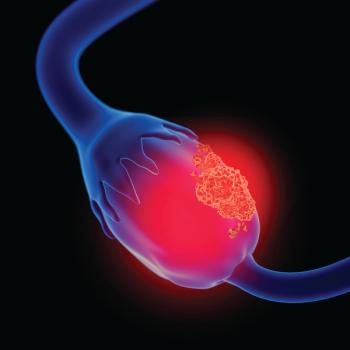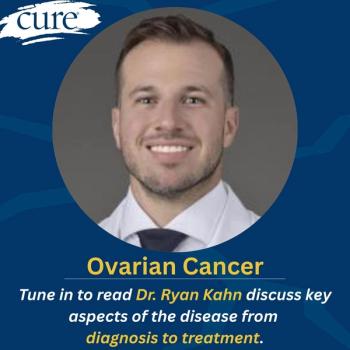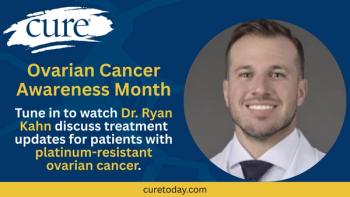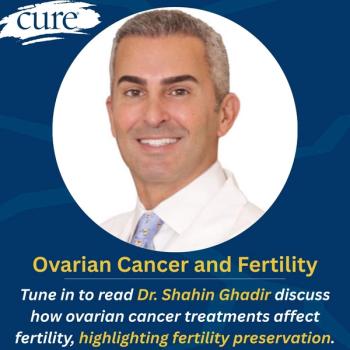
Ovarian Cancer: What is the Benefit of Maintenance Therapy?
Transcript:
Shubham Pant, M.D.: Dr. Eskander, there’s been a new approach, almost a revolution, in ovarian cancer but they use a maintenance therapy. You talked about that in the previous segment where patients have gone to chemotherapy and they can be put on something called maintenance therapy. So tell us a little more about that.
Ramez N. Eskander, M.D.: It’s certainly an important aspect of treatment now. It’s emerged in the last couple of years with approval of these PARP inhibitors. There are 3 FDA-approved PARP inhibitors — rucaparib, olaparib, and niraparib — for use in this setting. I anticipate in the future we may see more approvals. But basically, historically patients with recurrent ovarian cancer, whether it was platinum sensitive or not, would get chemotherapy, and then when they completed traditionally 6 cycles of chemotherapy, they would stop treatment and then initiate surveillance.
Shubham Pant, M.D.: Tell me a little what you mean by platinum sensitive.
Ramez N. Eskander, M.D.: The duration of time in which the cancer has gone away from completion of prior platinum therapy.
Shubham Pant, M.D.: OK.
Ramez N. Eskander, M.D.: If they completed their prior platinum therapy and at least 6 months elapsed between completion and recurrence, that’s defined as platinum-sensitive disease recurrence. If a patient progresses on their prior platinum therapy or recurs in less than 6 months, that’s a platinum-resistant or refractory patient population. In patients who have platinum-sensitive disease recurrence, the historical paradigm was to finish your chemotherapy and then do surveillance with clinical exams in CA125 [cancer antigen 125] and some people order imaging.
Now clinical trials have shown very reproducible efficacy using these PARP inhibitors as a maintenance treatment. What we mean by that is essentially when you’re done with your chemotherapy, at that point in time you don’t stop all treatment but you transition to this PARP inhibitor, like rucaparib or olaparib or niraparib. You initiate that maintenance, and you stay on that PARP inhibitor as a maintenance treatment as long as you’re responding and you don’t have toxicity that would mandate that you come off treatment.
That really was driven by several large clinical trials that showed in patients who got the placebo as a maintenance, the duration and time in which that cancer stayed away was approximately 5 months before it recurred versus in the patient population that got placed on the PARP inhibitor. This is dependent a little on whether you had a BRCA mutation in the tumor, inherited or not, but that was essentially 3-fold better. You’re talking about 15-, 20-month progression-free survival improvements.
Shubham Pant, M.D.: Let me break it down a little. There may be some repetition here, so I’m sorry for that. But let’s say you have BRCA1-, BRCA2-negative disease. When would you use maintenance therapy in that setting?
Ramez N. Eskander, M.D.: Right now you can’t use a PARP inhibitor as maintenance in the frontline if you’re not BRCA1 or BRCA2 mutated. But you can if you have a platinum-sensitive recurrence. The maintenance therapy in the platinum-sensitive recurrent setting is irrespective of BRCA.
Shubham Pant, M.D.: BRCA1 or BRCA2 status.
Ramez N. Eskander, M.D.: You got it.
Shubham Pant, M.D.: Let’s say you had cancer, you had it resected, chemotherapy then resected or chemotherapy after that, and then it came back and you have platinum-sensitive disease. That is more than 6 months of being disease-free after the end of platinum therapy. Correct?
Ramez N. Eskander, M.D.: Yes.
Shubham Pant, M.D.: Then technically they can get one of the maintenance therapies with 1 of the PARP inhibitors.
Ramez N. Eskander, M.D.: You got it.
Shubham Pant, M.D.: Tell me about BRCA1 and BRCA2, the ones who have BRCA1 and BRCA2 mutations, just like Doña here.
Ramez N. Eskander, M.D.: They would fall into the same basket, but the difference is that when I talk to a patient like Doña who has a BRCA mutation, the magnitude of benefit, based on the data that we have, appears to be a little more pronounced. But I want to highlight something, and this is the really important aspect, that when we look at these patients who are platinum-sensitive recurrent patients who are not BRCA1 or BRCA2 mutation carriers, there’s a whole family of genes independent of the BRCA genes that are involved in DNA repair that may have an alteration called homologous recombination deficiency, and that also may predict a robust response to these PARP inhibitors.
And aside from that, there may be other genes that we don’t know yet that may suggest response to therapy. Because there are patients, whom we would call biomarker negative, who still have a really robust and durable response to these maintenance PARP inhibitors. It’s a really exciting option to offer patients when historically we didn’t have anything in this setting. And more important, we know based on these studies that if we don’t offer a maintenance treatment that the average interval of time in which the disease stays away is about five months.
Shubham Pant, M.D.: That’s great. Dr. Hirst, if he can delay the next recurrence, what is the impact on mental health of patients — psychological health — if you can delay the recurrence coming back, delay the addition of chemotherapy again?
Jeremy Hirst, M.D.: I think certainly hearing that we now have these options can provide some sort of relief. Sometimes relief, sometimes control. Now we’re done with this intensive process of going into the infusion center and getting these chemotherapies. Now that we’ve got this maintenance therapy that’s going to keep fighting, we can provide a sense of control and relief.
The time period leading up to the next check-in with your physician or the next blood test or the next imaging study, for a lot of folks it is a time of increasing stress and worry. You can’t sleep for several days after you have the test and you’re waiting for the results. Then you get hopefully good results and you have this period of relaxation where you can say, “OK, things are OK again right now,” and then it builds up again. There’s this undulating experience of stress that we now have with this sort of maintenance idea.
Shubham Pant, M.D.: Doña, do you go through the same process? It’s called scan anxiety. Tell us a little about your experience as to what you go through.
Doña Harman: I get tested periodically for my CA125. And while I’m waiting for that result, yes, there’s anxiety because my life could change. It’s dependent on a number. And they’re always really good to get it to me as soon as they can, so it’s been good so far.
Shubham Pant, M.D.: Dr. Eskander, let’s say the CA125 has gone up or a scan shows recurrent disease. What is your conversation with the patients?
Ramez N. Eskander, M.D.: It’s a conversation that is essentially really tailored around their particular circumstance, based on all the things that we’ve discussed. How long have they been off chemotherapy, what is the elevation in their CA125? If they haven’t had imaging, is now the right time to do an imaging study to evaluate what their clinical exam is? Because all these things are going to inform what our options are for subsequent steps of treatment.
And one of the things that I think is also important to emphasize is, with adoption of maintenance therapy, by pushing that interval of time in which the cancer stays away before it recurs, that also gives our patients additional options down the line. Instead of having a disease that’s recurred in five months that’s platinum resistant potentially and less likely to respond to re-exposure to platinum, or where that patient may not be eligible for a platinum-sensitive clinical trial, by going on a maintenance therapy you can push out that disease-free interval. They’re now beyond that six months again. It gives you more therapeutic options and really puts you in a spot where options are key, because that’s what we want to do. As you mentioned earlier, it’s our dream to either cure patients or turn ovarian cancer into a chronic condition. If we’re able to do that successfully, then we’ve accomplished a lot.
Transcript Edited for Clarity




